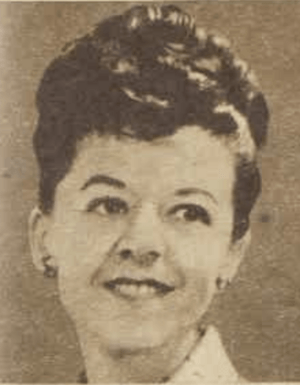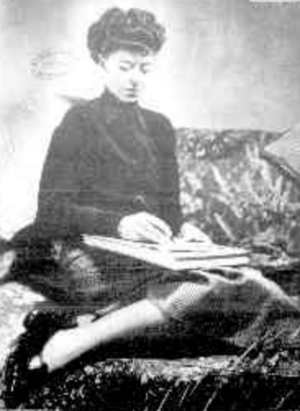Peggy Glanville-Hicks facts for kids
Quick facts for kids
Peggy Glanville-Hicks
|
|
|---|---|

Peggy Glanville-Hicks in 1948
|
|
| Born | 29 December 1912 |
| Died | 25 June 1990 (aged 77) |
Peggy Winsome Glanville-Hicks (born December 29, 1912 – died June 25, 1990) was an Australian composer and music critic. She was known for her unique musical style and her efforts to promote new music.
Contents
Her Life and Studies
Peggy Glanville-Hicks was born in Melbourne, Australia. She started learning music at a young age. She studied composition with Fritz Hart and piano with Waldemar Seidel at the Albert Street Conservatorium in Melbourne. A conservatorium is a special school where people learn about music.
From 1932 to 1936, Peggy studied at the Royal College of Music in London, England. There, she learned piano from Arthur Benjamin and conducting (leading an orchestra) from Constant Lambert and Malcolm Sargent. She also studied composition with the famous composer Ralph Vaughan Williams. She later said that a musical idea from her own piece, Sinfonietta for Small Orchestra (1935), was used by Vaughan Williams in his 4th Symphony. This idea also appeared in her 1953 opera The Transposed Heads. Peggy also had other important teachers, including Egon Wellesz in Vienna and Nadia Boulanger in Paris.
In 1938, Peggy Glanville-Hicks became the first Australian composer to have her work, a piece called Choral Suite, performed at an International Society for Contemporary Music (ISCM) Festival. This was a big achievement for her.
Working in New York and Greece
From 1949 to 1955, Peggy worked as a music critic for the New York Herald Tribune newspaper. A music critic writes reviews about musical performances and new compositions. She took over from Paul Bowles and worked under Virgil Thomson, another well-known music critic.
While working as a critic, she also continued to compose her own music. She became the musical director at the Museum of Modern Art in New York, where she helped organize music events. In 1949, she became a citizen of the United States.
After living in America, Peggy moved to Greece in 1957 and stayed there until 1975. In 1966, she had surgery to remove a brain tumor, which had affected her eyesight. The surgery helped her see again, but she lost her sense of smell.
Later Years and Legacy
Peggy Glanville-Hicks returned to Australia in her later years. She passed away in Sydney in 1990. Her friend, James Murdoch, wrote a book about her life.
In her will, Peggy created the Peggy Glanville-Hicks Composers' House. This is a special place in her former home in Paddington, Sydney, where composers from Australia and other countries can live and work on their music. This helps new composers create their own works.
To honor her, the New Music Network started the Peggy Glanville-Hicks Address in 1999. This is an annual speech given by a notable person in Australian music.
Her Music
Peggy Glanville-Hicks wrote many different kinds of music.
Instrumental Works
Her instrumental works are pieces written for musical instruments. Some of these include:
- Sinfonia da Pacifica: This piece was started in 1952 while she was on a boat trip. It was first performed in Melbourne the next year.
- Etruscan Concerto: This is a concerto for piano and orchestra. A concerto is a piece where one instrument plays a solo part with an orchestra.
- Concerto romantico: This is a concerto for viola and orchestra.
- Sonata for Harp: This piece was first played by Nicanor Zabaleta in 1953. It later won an award for being the Most Performed Contemporary Classical Composition at the APRA Music Awards of 1996.
Operas
Peggy Glanville-Hicks is perhaps best known for her operas. An opera is a play where the words are sung instead of spoken, usually with an orchestra.
- The Transposed Heads: This opera has six scenes and was based on a story by Thomas Mann. Peggy wrote the words for the opera, called the libretto. It was first performed in Louisville, Kentucky, in 1954.
- Nausicaa: This opera was composed in 1959–60 and first performed in Athens, Greece, in 1961. The story for the opera came from the novel Homer's Daughter by Robert Graves. This novel suggests that the famous Greek story The Odyssey was actually told by women. Peggy worked with Robert Graves' friend, Alastair Reid, to finish the libretto. The first performance of Nausicaa was a very important event in the world of opera and was a great success for Peggy. However, it has not been performed again since then.
- Sappho: This was her last opera, written in 1963. She hoped that the famous singer Maria Callas would sing the main role. However, the opera company did not choose to produce the work, and it was never performed during her lifetime. It was finally recorded in 2012.
Works
- Caedmon, opera (1933)
- Concertino da camera (1946)
- Letters from Morocco, for tenor and small orchestra (1952)
- Sinfonia da Pacifica (1952–1953)
- The Transposed Heads. A Legend of India, opera after the novel Die vertauschten Köpfe by Thomas Mann (1953)
- Three Gymnopedies, for oboe, celeste, harp, strings (1953)
- Etruscan Concerto, for piano and chamber orchestra (1956)
- Concerto Romantico, for viola and chamber orchestra (1956)
- The Glittering Gate, opera (1957)
- The Masque of the Wild Man, ballet (1958)
- Pelude for a Pensive Pupil, for piano (1958)
- Nausicaa, opera (1961)
- Sappho, opera, (1963), produced 2012.
- Saul and the Witch of Endor, television ballet (1964)
- Tragic Celebration (Jephtha's Daughter), ballet (1966)
See also
 In Spanish: Peggy Glanville-Hicks para niños
In Spanish: Peggy Glanville-Hicks para niños


